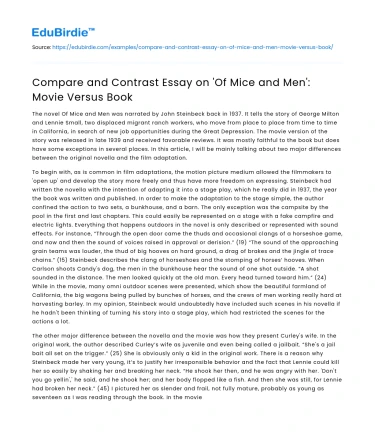The novel Of Mice and Men was narrated by John Steinbeck back in 1937. It tells the story of George Milton and Lennie Small, two displaced migrant ranch workers, who move from place to place from time to time in California, in search of new job opportunities during the Great Depression. The movie version of the story was released in late 1939 and received favorable reviews. It was mostly faithful to the book but does have some exceptions in several places. In this article, I will be mainly talking about two major differences between the original novella and the film adaptation.
To begin with, as is common in film adaptations, the motion picture medium allowed the filmmakers to 'open up' and develop the story more freely and thus have more freedom on expressing. Steinbeck had written the novella with the intention of adapting it into a stage play, which he really did in 1937, the year the book was written and published. In order to make the adaptation to the stage simple, the author confined the action to two sets, a bunkhouse, and a barn. The only exception was the campsite by the pool in the first and last chapters. This could easily be represented on a stage with a fake campfire and electric lights. Everything that happens outdoors in the novel is only described or represented with sound effects. For instance, “Through the open door came the thuds and occasional clangs of a horseshoe game, and now and then the sound of voices raised in approval or derision.” (19) “The sound of the approaching grain teams was louder, the thud of big hooves on hard ground, a drag of brakes and the jingle of trace chains.” (15) Steinbeck describes the clang of horseshoes and the stomping of horses’ hooves. When Carlson shoots Candy's dog, the men in the bunkhouse hear the sound of one shot outside. “A shot sounded in the distance. The men looked quickly at the old man. Every head turned toward him.” (24) While in the movie, many omni outdoor scenes were presented, which show the beautiful farmland of California, the big wagons being pulled by bunches of horses, and the crews of men working really hard at harvesting barley. In my opinion, Steinbeck would undoubtedly have included such scenes in his novella if he hadn't been thinking of turning his story into a stage play, which had restricted the scenes for the actions a lot.
Save your time!
We can take care of your essay
- Proper editing and formatting
- Free revision, title page, and bibliography
- Flexible prices and money-back guarantee
The other major difference between the novella and the movie was how they present Curley's wife. In the original work, the author described Curley’s wife as juvenile and even being called a jailbait. “She's a jail bait all set on the trigger.” (25) She is obviously only a kid in the original work. There is a reason why Steinbeck made her very young, it’s to justify her irresponsible behavior and the fact that Lennie could kill her so easily by shaking her and breaking her neck. “He shook her then, and he was angry with her. 'Don't you go yellin',' he said, and he shook her; and her body flopped like a fish. And then she was still, for Lennie had broken her neck.” (45) I pictured her as slender and frail, not fully mature, probably as young as seventeen as I was reading through the book. In the movie version, the role was played by Betty Field, who was born in 1913 and would have been twenty-six when the picture was made. Her character is a hard-boiled, worldly-wise woman who should have known better than to be flirtatious with Lennie, the mentally limited giant who crushed her husband's hand to a pulp and has just killed a puppy by petting it too hard.






 Stuck on your essay?
Stuck on your essay?

